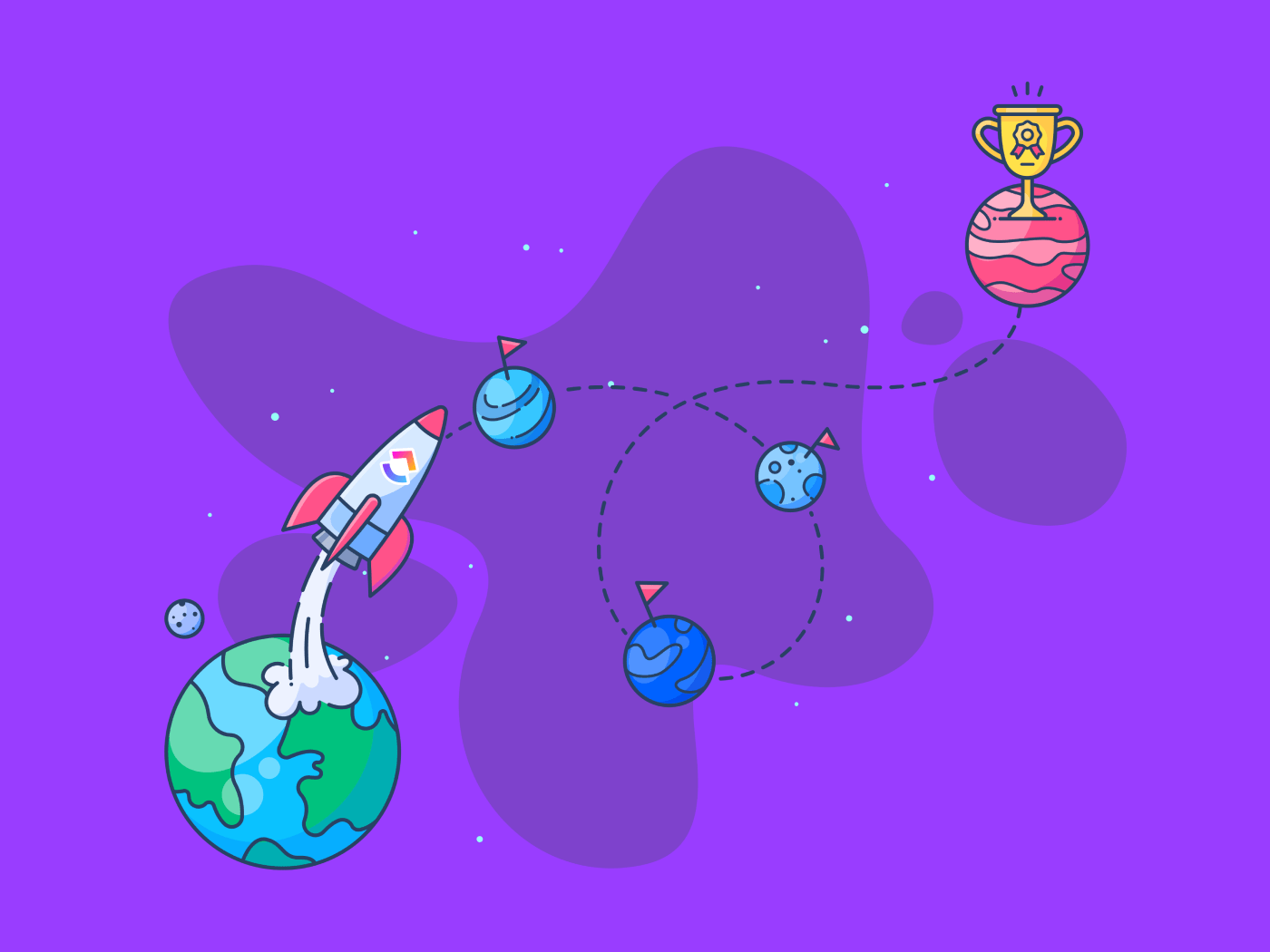

Once upon a time, two thriving SaaS companies, each at the top of their game, took entirely different approaches to growth.
Company A let its product do the heavy lifting—offering a freemium model that attracts users like bees to honey, banking on the product’s viral adoption to drive expansion. They worked hard to perfect the product to the point where it became its own marketing engine.
Meanwhile, Company B was laser-focused on its customers, pouring resources into understanding even the smallest needs and personalizing solutions accordingly. They relied on building a loyal customer base and word-of-mouth referrals to drive growth.
Though both companies are successful, their growth paths couldn’t be more different.
As a SaaS (Software as a Service) business owner or professional, it is important to determine which strategy aligns with your company’s goals, resources, and market position.
This blog explores customer-led vs. product-led growth with benefits, downsides, applications, and more.
Understanding Product-Led Growth
Product-led growth (PLG) represents a massive shift in gears in the SaaS industry. In this model, the product is front and center and becomes the primary driver of customer acquisition, conversions, and business expansion.
In product-led companies, products are designed to deliver immediate value, allowing users to experience their benefits firsthand before making a purchasing decision. This approach aligns with a modern user’s preference for self-service and a try-before-you-buy experience.
Take Slack, for instance. It lets users collaborate seamlessly with teams through its intuitive interface—all without upfront costs.
With features like multiple channels, tags, and centralized file-sharing, Slack quickly gained users by highlighting its efficiency and collaboration benefits. As teams adopted Slack, they invited others to collaborate with them on the platform, fueling Slack’s viral growth.
Expectedly, PLG emphasizes creating products that are intuitive, valuable, and easy to adopt, which drives sales. This allows them to lower customer acquisition costs by letting the product do most of the talking.
As users interact with the product, they naturally progress through the customer journey, converting to paid plans from the free trial and driving organic growth through viral adoption.
Product-led vs. sales-led growth
While PLG companies put the product at the heart of growth, sales-led growth (SLG) takes a traditional approach that relies on sales teams to engage with prospects, nurture leads, and close deals. It typically involves personalized outreach and product demonstrations. This means a more hands-on approach to guiding potential customers through the buying process.
SLG works best in industries where the product is complex and needs significant customization. It also targets larger enterprise clients who prefer a high-touch sales experience.
The key difference between PLG and SLG lies in who leads the customer journey.
In PLG, the product itself is the primary touchpoint, allowing users to experience its value independently, whereas SLG requires the sales team to communicate the product’s value.
PLG for B2B: A perfect fit or just for SaaS?
The product-led growth strategy is often associated with SaaS companies, but it’s not limited to this space. The essence of PLG—letting the product itself drive growth by showcasing its value—can work well in many B2B environments.
Consider Dropbox as a case in point.
Although Dropbox is primarily recognized as a SaaS product, its freemium model demonstrates how PLG can succeed in a B2B environment.
It offers businesses and individuals free storage space with a simple, intuitive interface that works across devices. This ease of use attracted millions of users, including many B2B clients, who quickly recognized the product’s value.
As these clients’ storage needs grew, many upgraded to paid plans, driving business growth without the heavy involvement of sales teams.
So, while PLG shines in SaaS marketing strategies, its principles can also be adapted to other B2B scenarios. If your product can deliver immediate value and let users experience its benefits firsthand, it’s likely to drive growth, whether you’re in SaaS or another B2B sector.
Also Read: 10 Best Product-Led Growth Software Tools
Understanding Customer-Led Growth
Customer-led growth (CLG) is a strategy that places customers at the crux of a company’s growth initiatives. It invests more in customer success and satisfaction scores as the primary drivers of business expansion.
CLG emphasizes building deep relationships and creating positive experiences at every stage of the customer journey.
CLG focuses on making customers happy because they see them as the best advocates for your brand. By surpassing their expectations, you can turn them into loyal supporters and, ultimately, the primary drivers for growth.
This means delivering exceptional experiences from the very first interaction all the way through to ongoing support.
A great example of CLG in action is Amazon. The online marketplace has grown based on customer satisfaction, offering personalized recommendations, reliable shipping services, and a hassle-free return policy.
Amazon’s ability to anticipate and meet customer needs through a highly responsive global customer service team has established it as a trusted option for millions around the world, driving both loyalty and repeat business.
Similarly, customer success is another crucial element of CLG. Your team should understand customers’ goals, guide them, and help them get the most out of your product.
Customer-led growth often leads to higher customer lifetime value (CLV) because when clients are happy, they tend to return for more.
On top of that, happy customers are your best promoters. They’ll recommend your brand to their friends and family and may even stand up for you if any negative comments come your way. This creates a positive customer feedback loop that drives repeat business and strengthens your brand’s reputation over time.
Consumer behavior and its influence on CLG
Today’s consumers are more informed, connected, and empowered than ever before. They have access to a wealth of data and are quick to share their experiences—positive or negative—through social media and other platforms.
This requires you to be highly attuned to user behavior, preferences, and expectations, especially if you’re pursuing success in a customer-led strategy.
Understanding their behavior involves analyzing how they interact with a brand and what drives their purchasing decisions. This includes factors that steer them away from or near your product’s features.
Pro Tip: Data and analytics can help you understand customers’ fluctuating behavioral patterns and create offerings accordingly.
For example, a brand that notices a trend of customers valuing eco-friendly products may adjust its product line to include more sustainable options. It can strengthen loyalty and drive growth by aligning with what customers care about.
Why customer touchpoints and user-generated content are key
Customer relationship management (CRM) is crucial for driving CLG because it helps brands build strong connections with their audience.
When you manage relationships effectively, every interaction feels personal and meaningful, making customers feel valued. This strengthens loyalty and encourages repeat business, which is key for long-term growth.
Airbnb is a great example of this. They’ve grown by focusing on creating memorable experiences for both hosts and guests.
By offering resources and support that prioritize trust and safety, they’ve built strong relationships that keep people coming back. These positive experiences are what make CLG so effective.
Touchpoints, the moments when customers interact with your brand—whether on your website, social media, or during a purchase—are opportunities to create positive experiences. Consistently delivering at these touchpoints builds trust and keeps customers engaged, which is essential for CLG.
A well-executed customer lifecycle marketing strategy ties all of this together by ensuring that your messaging and engagement evolve as customers move through different stages of their journey.
Likewise, UGC (user-generated content) is another powerful driver of CLG (and PLG in some cases). When customers share their experiences with your product, it acts as authentic social proof that can influence others.
Encouraging user engagement and showcasing UGC boosts your brand’s credibility and creates a sense of community, further strengthening customer loyalty and driving growth.
PLG vs. CLG: The Advantages and Disadvantages
Let’s start by looking at the benefits and drawbacks in our customer-led vs product-led growth debate.
Here are the benefits of PLG vs. CLG:
| Product-led growth pros | Customer-led growth pros |
| Enables rapid scaling through organic, viral growth as the product sells itself | Fosters strong relationships, leading to higher satisfaction, loyalty, and advocacy |
| Reduces reliance on expensive sales and marketing efforts | Products and services are closely aligned with customer needs based on feedback |
| Generates valuable customer data that informs product refinement and customer experience | Satisfied customers remain loyal, driving higher CLV and ongoing revenue growth |
Here are the drawbacks of PLG vs. CLG:
| Product-led growth cons | Customer-led growth cons |
| Lacks the personalized touch expected in complex B2B environments | Requires significant investment in customer success software, teams, and personalized services |
| Success hinges entirely on the product’s ability to deliver immediate value | Growth may be slower due to the need for more hands-on interaction and tailored solutions |
Next, let’s understand how each strategy affects customer satisfaction and experience.
In PLG, customer satisfaction relies on how well the product works and how quickly it delivers value. If it’s easy to use and meets expectations, customers are happy.
But if it’s not up to par, satisfaction can drop quickly.
With CLG, it’s all about the entire customer experience. This approach focuses on making customers feel valued throughout their journey, often through human interactions and support. This boosts overall satisfaction and loyalty.
The impact of usability on both growth strategies
Usability is what carries your PLG strategy forward. This means your product needs to be intuitive, easy to use, and capable of proving its value immediately.
If a user struggles with the product or finds it complicated, it hinders growth. You simply cannot compromise on usability in PLG because this factor decides whether your users continue after the initial trial or freemium period.
While usability is still essential in CLG, it’s complemented by the broader customer experience. Even if a product has a learning curve, a dedicated customer success team can guide users through the process till they achieve their desired outcomes.
All in all, the best approach may involve a combination of both strategies.
Transforming Marketing and Sales with PLG and CLG
While a product-led sales strategy makes your product the centerpiece, CLG revolves around deepening customer relationships and prioritizing customer success. Many factors go into determining which growth strategy is the right fit for your organization, including your industry, your ICP (ideal customer profile), the nature of your product, etc.
Many organizations choose to do both: Where PLG is the way forward for smaller clients or individual users, while CLG helps pave the way for large enterprise clients who need extensive customizations.
Either way, implementing PLG and CLG strategies can improve your marketing roadmap and sales efforts to fuel considerably higher conversions and revenue. Consider using a marketing and sales management tool to develop and track foolproof PLG and CLG strategies.
ClickUp’s Product Management Software is a versatile platform designed to enhance your growth strategy.
Let’s show you how ClickUp can be a powerful tool to support both product-led and customer-led growth.
Apply innovative additions with mind maps
Innovation plays a crucial role in driving growth, whether through product-led or customer-led strategies. It’s important to organize your ideas in a way that leads to clear, actionable steps.
Mind maps can be incredibly useful for this, offering a visual way to structure your thoughts and see how different ideas connect.
For instance, if you’re brainstorming ways to improve a product feature or enhance customer experience, a mind map can help you break down these concepts into more manageable parts. This ensures that every detail is considered and nothing is overlooked.
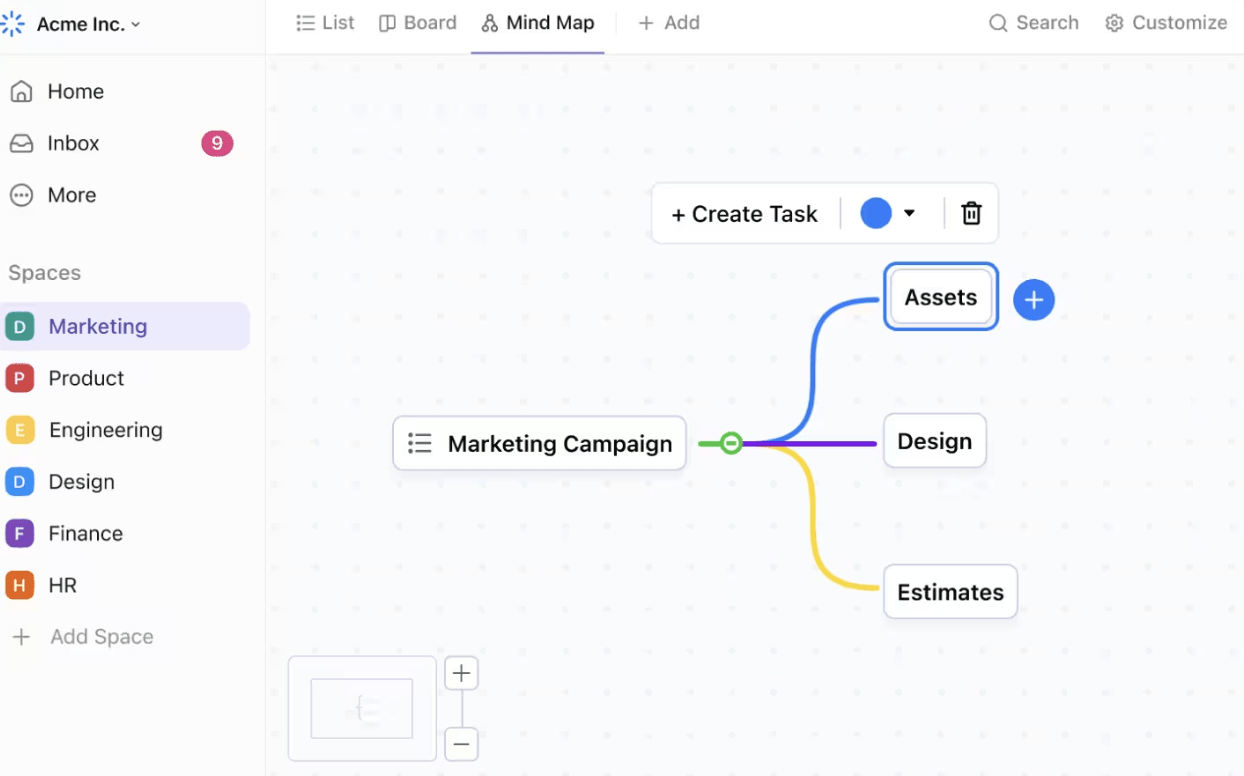
ClickUp’s Mind Maps facilitate this process perfectly by allowing you to build comprehensive product development lifecycles and spot areas for optimization.
You can create flowcharts and workflows that guide your product from the initial idea to the final launch. By visualizing each phase of your product’s journey, you can ensure that your growth marketing strategies are both innovative and effective.
Test different data views for several perspectives
Gaining different perspectives on your business strategy is essential for its success. You need to consult product and UX experts as well as sales, and customer experience teams. By looking at your plans from various angles, you can identify potential gaps and opportunities that might otherwise go unnoticed.
ClickUp Views enable you to do just that, offering different ways to visualize and manage your tasks and projects.
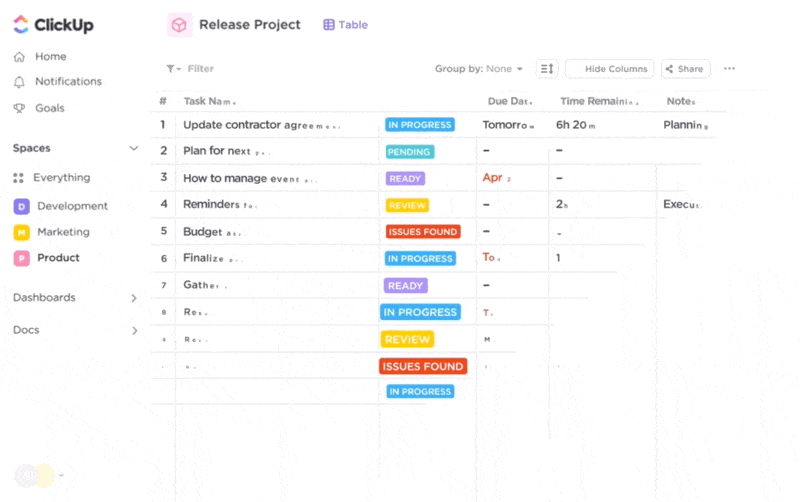
For example, the ClickUp Board View can be particularly useful for tracking the progress of your product development timelines and managing feature requests. By dragging and dropping tasks across different columns, you can easily see where your project stands and what needs to be done next.
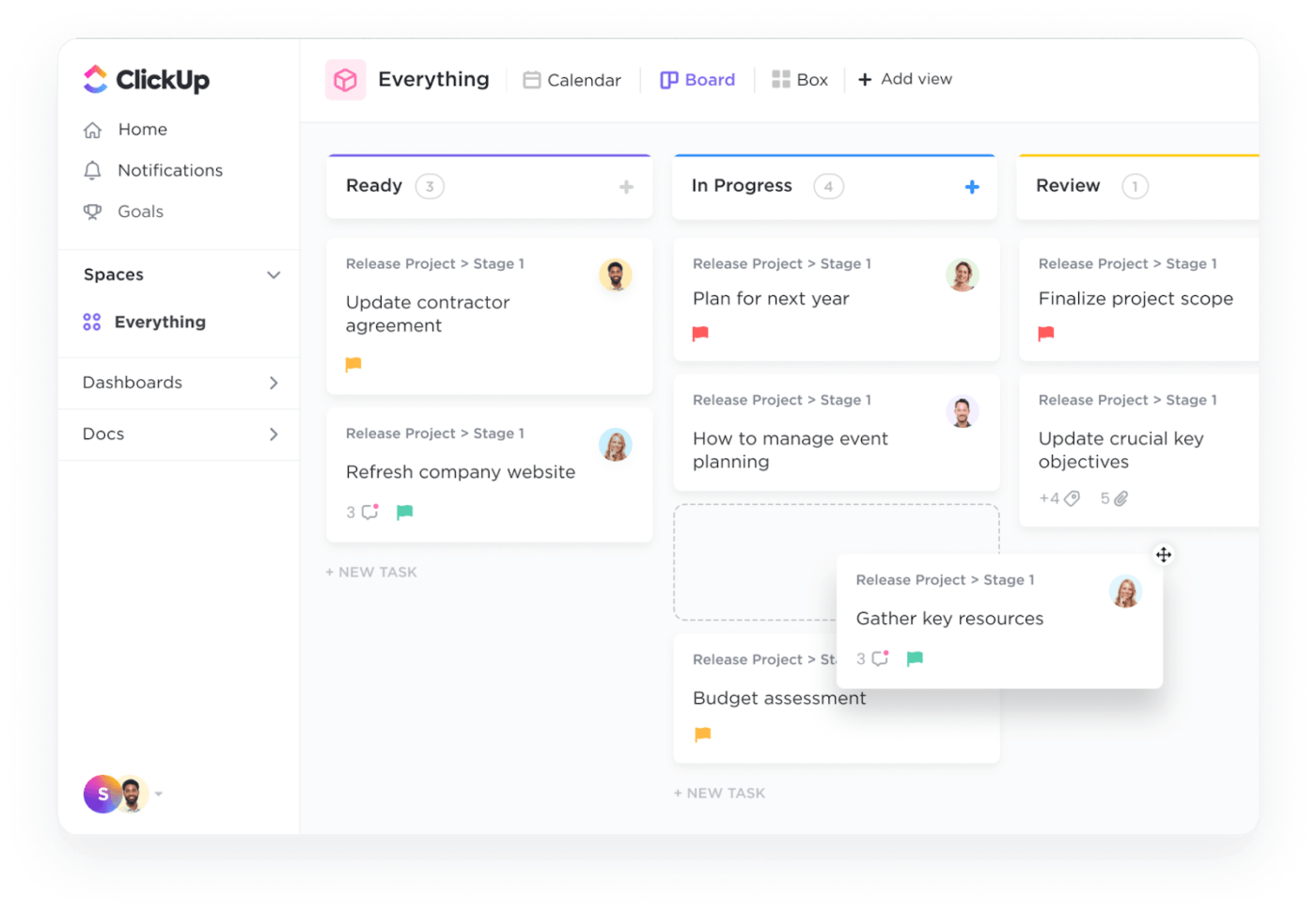
The ClickUp Calendar View helps you stay on top of deadlines and milestones, ensuring your team stays on track.
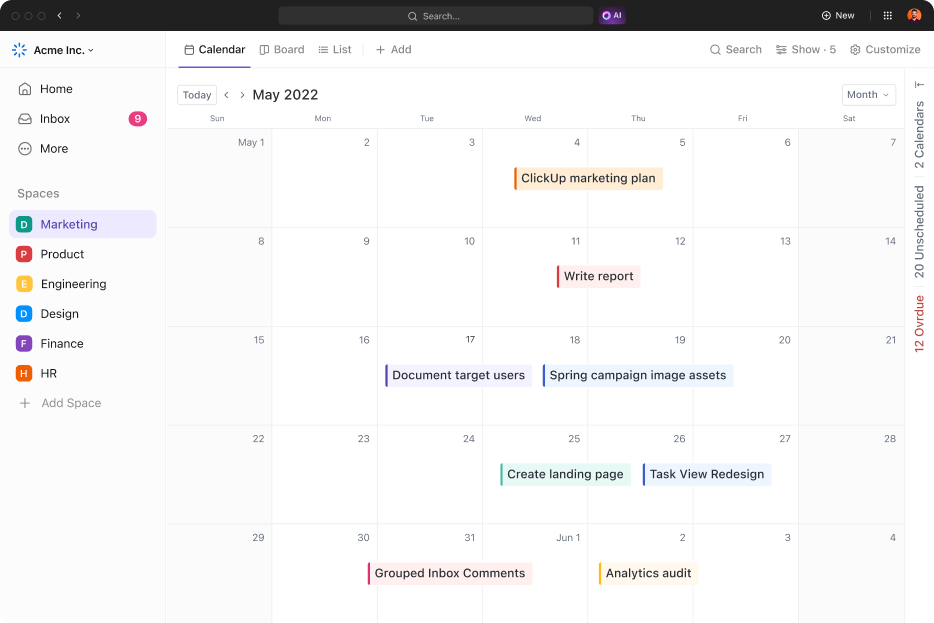
Meanwhile, the ClickUp List View provides a more detailed look at each task, making it easier to manage the finer details of your growth strategy.
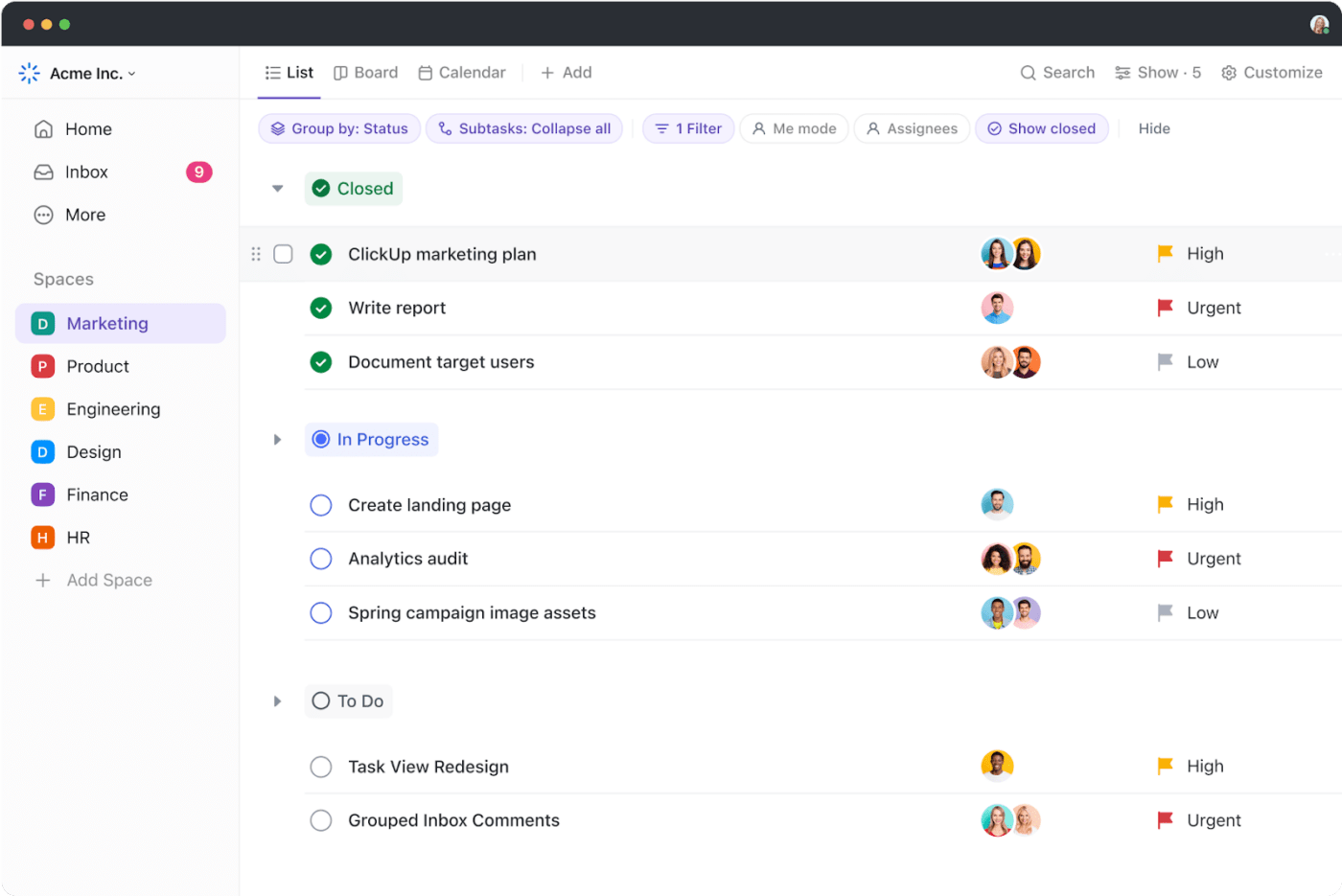
Create cohesion in your marketing team
A cohesive marketing team is essential for executing any growth strategy effectively. When everyone is on the same page, tasks are completed more efficiently, and there’s less risk of miscommunication.

Avoid scattered project documents and communications by implementing ClickUp’s Marketing Solution.
You can use it interchangeably for product design or customer retention strategies. Even better, different departments in your organization can collaborate on files, multiple communication mediums, and 1,000+ integrations—all from a single unified platform.
The marketing team can apply different charts to spot loopholes and other friction points in your growth strategy.
Make sure to set up ClickUp’s Dashboards and customize them to showcase detailed insights into your product and marketing strategies. This will transform your dashboard into a dynamic analytical hub.
Think of it as your command center for data, where you can set up widgets that track key metrics, visualize performance trends, and break down complex information into actionable insights.
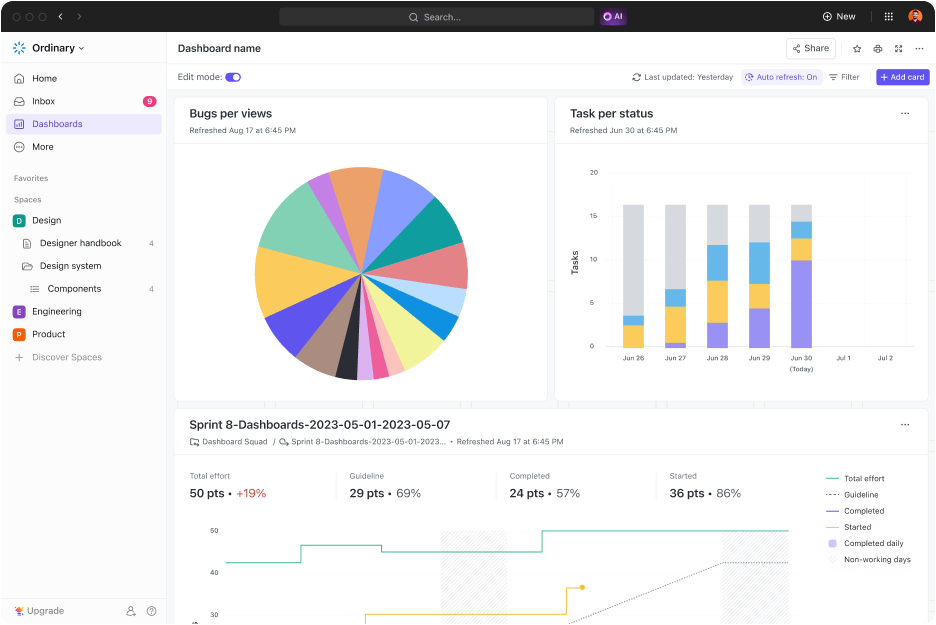
By tailoring your dashboard, you can monitor progress across various projects, pinpoint successes and areas for improvement, and make informed decisions on the fly.
Use whiteboards to ideate PLG and CLG strategies
Whiteboards are ideal for brainstorming and visualizing growth strategies. They offer a flexible space to map out your ideas, regardless of which model you’re working with.
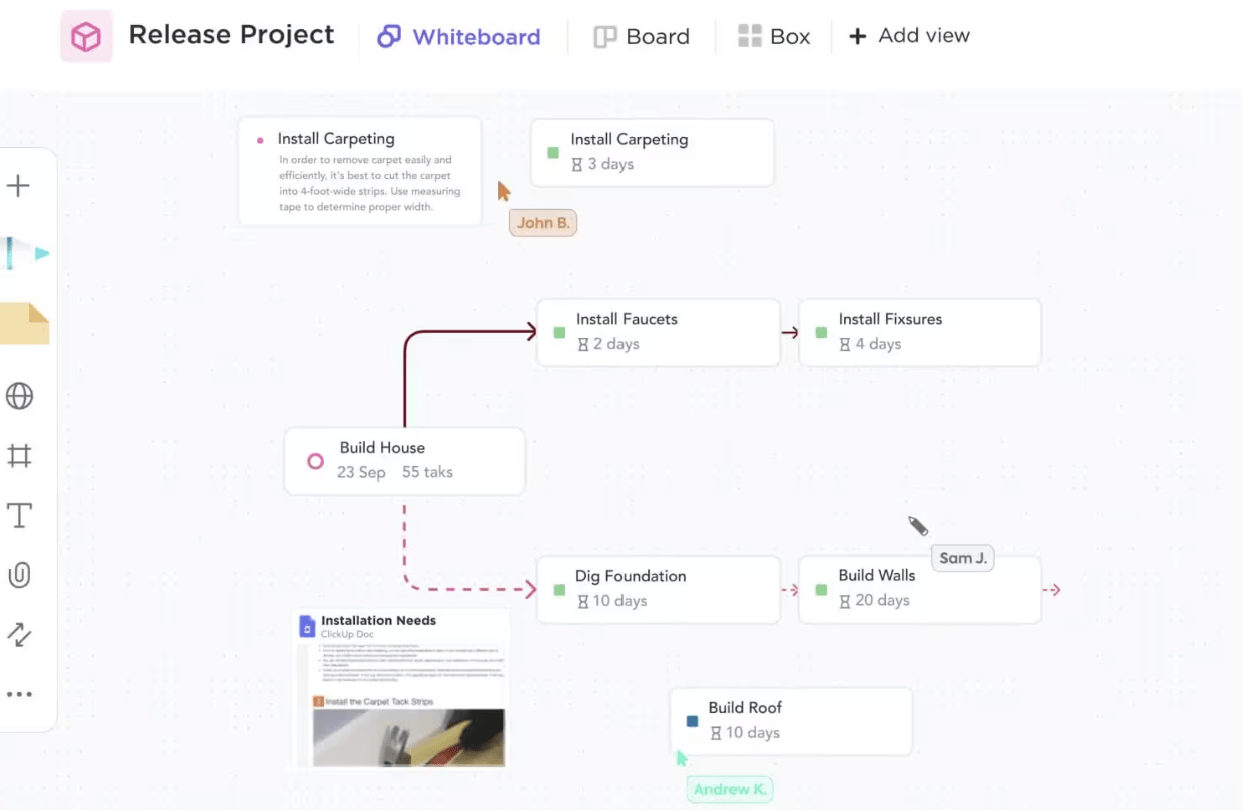
ClickUp Whiteboards are perfect for brainstorming and planning your growth in an interactive, collaborative way.
If you’re a product-led company, use Whiteboards to map out user journeys, from the initial onboarding to feature adoption and even paid upgrades. It’s also a great tool for laying out A/B testing scenarios to ensure your strategy is on track.
However, if you’re focusing on CLG, Whiteboards help you track and visualize customer touchpoints throughout their journey. You can chart the entire marketing funnel together with your team, ensuring every interaction is optimized.
Plus, with real-time collaboration, multiple teams can work together seamlessly to enhance customer service and drive success.
Deploy AI tools for rapid insights
AI tools can transform how you gather and analyze insights, speeding up your decision-making process. These tools excel at handling large amounts of data, spotting trends, and delivering actionable insights quickly.
They automate tasks like data extraction, trend analysis, and report generation, freeing you to focus on strategic planning rather than manual work.
AI-driven solutions are particularly valuable for tasks such as transcribing meetings, summarizing lengthy documents, and identifying key information within your data. This enhances efficiency, improves accuracy, and reduces the potential for human error.
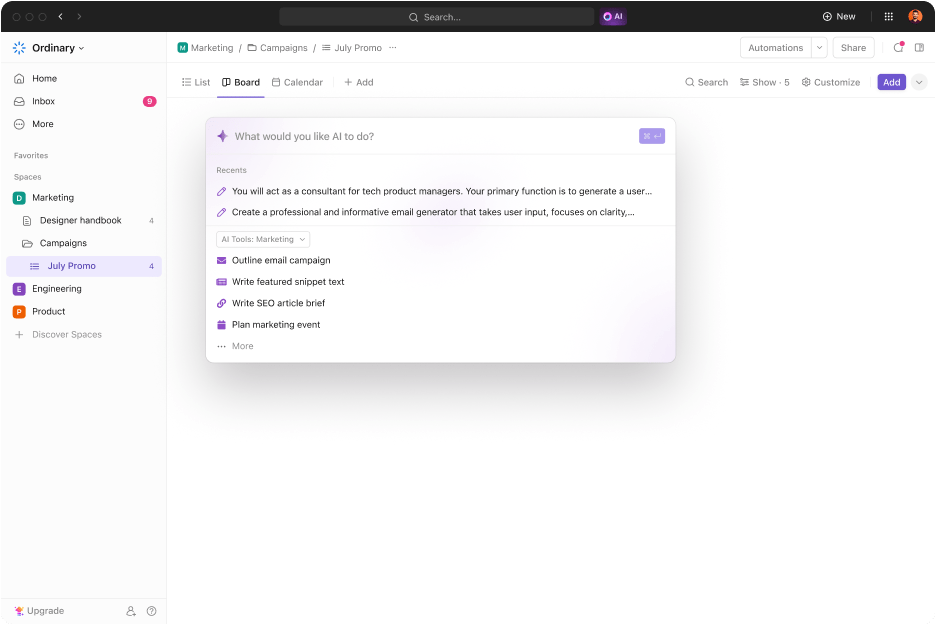
ClickUp Brain can take this a step further.
It enables you to create detailed reports, generate voice-to-text transcriptions, and pull specific keywords from your files. This intelligent assistant integrates seamlessly with your tasks, projects, and team activities, offering a comprehensive view and accelerating your execution with over 100 specialized tools.
Implement pre-designed templates for growth
Templates are incredibly valuable for executing growth strategies. They offer a ready-made framework that you can tailor to meet your specific needs, starting off your team with a solid foundation.
With ClickUp’s extensive library of templates, you can streamline your growth efforts. These templates provide structured guidance, helping you efficiently manage your strategies and track progress without reinventing the wheel.
ClickUp Product Roadmap Template
The Product Roadmap Template by ClickUp helps you visualize every stage, from the initial concept to the final launch, ensuring nothing is overlooked.
With this template, you can break down tasks, allocate resources, and keep everything running smoothly.
To make the most of the Product Roadmap Template, start by outlining your product’s goals. Next, map out key milestones and prioritize the features you’ll need to reach those milestones.
Finally, ClickUp Custom Statuses and Custom Fields will help you track progress and make informed decisions.
ClickUp Product Strategy Template
Another option for PLG is ClickUp’s Product Strategy Template, which lets you build practical roadmaps to nurture and position your product teams on the right path.
Begin by defining your product’s purpose and the problems it solves. (to do this, the team must also conduct thorough market research to understand competitors and identify opportunities for innovation.)
Then, set measurable goals and break them down into actionable tasks using this template. This approach provides a clear plan of action and helps track progress effectively.
Regularly review and update your strategy based on performance and user feedback to keep your development on track.
Also Read: Top 12 Product Marketing Software for Growth
The Use of PLG and CLG in Successful SaaS Companies
Here’s how companies like HubSpot and Salesforce have leveraged these approaches to drive SaaS operations.
HubSpot’s transition from sales-led to product-led growth
Initially, HubSpot relied heavily on a sales-driven strategy, but as they evolved, they shifted to a product-led approach.
- Freemium model: By offering free tools with limited features, HubSpot attracted a large number of users. This model allowed potential customers to experience the product’s value firsthand before making a purchase decision
- Growth benefits: This shift enabled HubSpot to scale rapidly by leveraging the product’s usability and effectiveness as a driving force behind growth. The transition helped HubSpot establish itself as a key player in the inbound marketing space
Salesforce’s focus on customer-led growth
Salesforce has built its reputation by prioritizing customer success and creating a robust community around its product.
- Customer satisfaction: Salesforce invests heavily in customer success teams that work closely with clients to ensure they achieve their goals and derive maximum value from the platform
- Community building: Salesforce has also fostered a vibrant community through its events, user groups, and online forums. This approach strengthens customer relationships and creates valuable feedback loops for continuous product improvement
Which Is the Best Growth Strategy for Your SaaS Business?
The choice between customer-led and product-led growth depends on your product’s unique context, including its nature, target audience, and market dynamics.
PLG is ideal if your product can deliver immediate value with minimal sales intervention, making it perfect for scalable, self-service models. On the other hand, CLG shines in business ecosystems where deep customer bonds and personalized experiences are critical to driving growth.
Many successful SaaS companies integrate elements of both PLG and CLG. But no matter your path to growth, ClickUp is how you’ll get there.
From Mind Maps and Whiteboards for brainstorming and Views for tracking progress, ClickUp offers powerful integrations to enhance collaboration while executing your growth strategy.
Are you ready to take your SaaS journey to the next level? Sign up to ClickUp for free today!





